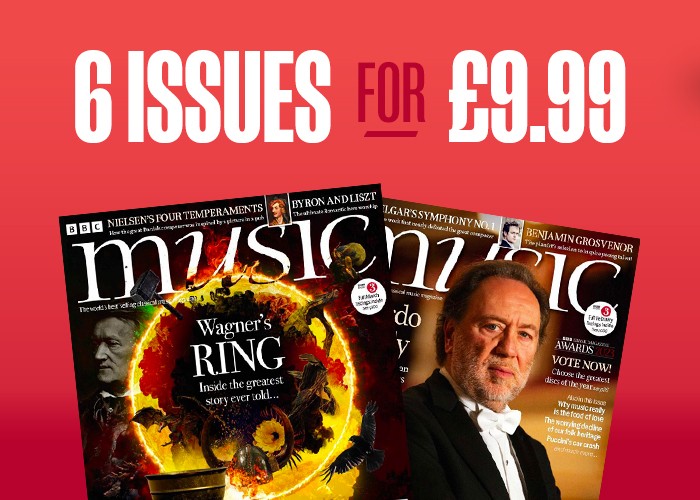The Walton Viola Concerto: a guide to his viola masterpiece and its best recordings
With this unexpected, subtle masterpiece, Walton established himself as a major composing talent; Julian Haylock finds the best recordings of his Viola Concerto

Walton’s Viola Concerto established at a stroke his unique creative voice. For several years he had tried distilling the dazzling stylistic range of his Façade (1921) into a convincing long-range structure. There are hints of what was to come in the Portsmouth Point overture and orchestral Siesta, as well as 1927’s Sinfonia Concertante for piano and orchestra.
Yet, as The Times remarked as part of a generally enthusiastic review of the latter, ‘Mr. Walton has not yet fully found his individuality’.
When did Walton compose his Viola Concerto?
In 1928, on a winter holiday in Amalfi, Italy, Walton began making provisional sketches for the Viola Concerto, but his heart wasn’t really in it.
It was the conductor Thomas Beecham who had first suggested he write a concerto for British viola supremo, Lionel Tertis – although Walton was at a loss to see why. At the time, Walton could barely stand the instrument, which he thought made ‘an awful sound’, and could recall only one decent piece of viola music, Berlioz’s Harold in Italy.
Yet Beecham had clearly spotted something conducive in Walton’s emerging style to the viola’s soulful musical voice – the sense of a lone introspective pitted against the combined might of a modern symphony orchestra. As the 26-year-old Walton warmed to his task, he discovered this was indeed the perfect vehicle for uniting the seemingly disparate elements in his musical personality.
The nostalgic longing at the heart of his creative universe became fused with a rhythmic pizzazz, harmonic pungency and melodic vitality that would become indelible trademarks of his later work. Not only that, but he fully immersed himself in the viola’s elusive soundworld, combining its natural flair for bittersweet cantabile eloquence with a previously unsuspected penchant for pyrotechnics.
Convinced he had a masterwork on his hands, Walton duly sent the completed manuscript to Tertis for his approval. However, in their enthusiasm, both Beecham and Walton had overlooked Tertis’s conservative nature.
Declaring the work ‘too modern’, Tertis flatly refused to play it. It was only after attending the premiere, with ‘shame and contrition’ (as he put it in his autobiography), that he dramatically revised his opinion and became an enthusiastic advocate.
When was Walton's Viola Concerto first performed?
Mind you, according to Behind the Façade, Susanna Walton’s unputdownable biography of her late husband, one particular performance of the concerto given by Tertis in Worcester fell on an especially famous pair of ‘deaf’ ears.
Walton happened upon Edward Elgar – never a fan of the younger composer’s music at the best of times – in the gents’ cloakrooms. Elgar muttered that Walton had ‘murdered the poor unfortunate instrument’, and seemed much more interested in catching the latest racing results.
Walton was so hurt by Tertis’s rejection that he considered briefly recasting the work for the violin, but at this point fate intervened in a quite unexpected way. Whether it was by Tertis (according to his memoirs) or Edward Clark of the BBC Music Department (according to Walton’s recollections in the Sunday Telegraph in 1962), an alternative viola soloist was suggested, guaranteed to generate huge interest: leading German composer Paul Hindemith, then in his mid-30s and with around 50 published works to his name. Hindemith had started out as violinist and then switched to viola following the First World War, as a founding member of the Amar Quartet.
Hindemith willingly agreed to give the premiere, although that wasn’t quite the end of the matter. Hindemith’s London publishers felt that the then famous Courtauld-Sargent series of concerts was a more fitting setting for Hindemith’s UK concerto debut than the ‘worthy’ but ‘so-so playing’ they thought typified the Promenade Concerts.
More like this
Nevertheless, Hindemith went ahead with the planned Proms premiere at the Queen’s Hall on 3 October 1929. However, Walton quickly regretted having offered to conduct, as there turned out to be innumerable tiny errors in the orchestral parts, which he then had to stay up all night correcting, just in time for the concert. Hindemith, although deeply committed to the project and technically highly proficient, turned out to be somewhat unyielding. Accordingly to Walton, ‘he just stood up and played’.
Yet despite any behind-the-scenes problems, the premiere was extremely well received, and as a result Walton became the toast of the rising generation of British composers. And little wonder. He achieves near-miracles by making the viola’s relative lack of sonic penetration of positive benefit, interweaving and dovetailing it with the orchestra – especially in the central scherzo – with a Mendelssohn-like deftness of touch.
This is enhanced still further by Walton’s 1961 reorchestration, which highlights the concerto’s quicksilver textures, jazz-fuelled rhythmic asides and bluesy nostalgia. All three movements embrace music that is somehow virtuosic, yet not showy; bold and exuberant in places, yet profoundly intimate, and tinged with an autumnal reflectiveness.
We named Walton's Viola Concerto one of the best pieces of viola music
The best recordings of Walton Viola Concerto
Lawrence Power (viola)
BBC Scottish Symphony Orchestra/Ilan Volkov
Hyperion CDA 67587
The 30-odd available recordings of Walton’s Viola Concerto generally fall into one of two main camps: those who tend towards a more rounded, soulful, alto cello sonority, and those more inclined towards a leaner, brighter, violinistic quality. However, one player stands out as combining the best of all worlds: Lawrence Power.
Technically, Power appears almost impervious to Walton’s not inconsiderable technical demands, delighting in those tricky sleight-of-hand manoeuvres that others find a shade taxing. Yet he also captures Walton’s cantabile espressivo with complete assuredness, tantalising the senses with a soaring intensity that time and again scores an emotional bullseye without ever becoming sentimental.
Most importantly, Power possesses the ideal soundworld to convey Walton’s iridescent emotional complexities. This is music that tantalises by gently veiling its expressive core behind a smoky veneer of semantic elusiveness, and more than any other player, Power matches this half-spoken quality with a tonal sophistication that in the central scherzo impishly skirts around generic norms.
One of the most compelling (and counter-intuitive) aspects of Walton’s music is that the more unmistakably direct in expression it becomes, the less convincing and personal it feels, and Power captures this emotional ambiguity both gesturally and tonally.
Walton’s 1961 revision reduces the woodwind from triple to double, the trumpets from three to two, removes the tuba altogether and adds a harp. It is this version that has invariably been played and recorded ever since. Tellingly, Power elected to return to Walton’s original scoring of 1928/9, and the result is a darker, moodier, more uncompromising soundscape that is brought compellingly to life by the BBC Scottish Symphony Orchestra under its then (September 2006) chief conductor, Ilan Volkov.
Matching Power’s inspirational playing, the orchestra captures the ebb and flow of Walton’s music with suppleness of line and enticing spontaneity, generating an atmosphere of barely restrained brooding power, captured in immaculately balanced, glowing sound by production team Andrew Keener and Simon Eadon.
The concerto was inscribed ‘To Christabel’ (Christabel McLaren, Lady Aberconway), with whom Walton was unrequitedly infatuated at the time. No other performance captures the work’s spirit of modified rapture so keenly.
William Primrose (viola)
Naxos 8.110316
Despite an occasional slight untidiness along the way, William Primrose’s July 1946 recording, with Walton conducting the Philharmonia, remains a must-hear for its no-nonsense emotional clarity. Primrose’s unmistakably violinistic, rapier-like thrust (shades of Jascha Heifetz in the Violin Concerto) generates the greatest excitement, surfing the fulsome textures of the original scoring with a charismatic intensity that few other players can match. Primrose virtually defined for two decades how this work should sound.
James Ehnes (viola)
Chandos CHSA 5210
Finest of all the violin virtuosos who stray occasionally into viola territory is James Ehnes. Those listeners who incline naturally towards the viola’s plangent chestiness may feel slightly short-changed here, yet Ehnes produces a uniquely smooth, immaculately focused sound throughout the range, his intonation is spotless, and he seamlessly negotiates the score’s many intricacies. Edward Gardner and the BBC Symphony Orchestra respond with alacrity, complementing Ehnes’s eloquent advocacy with playing of radiant distinction, captured in gloriously immersive, impactful sound. (Chandos CHSA 5210)
David Aaron Carpenter (viola)
Warner Classics 90295 68769
When originally reviewing David Aaron Carpenter’s beguiling account of the Walton Concerto, supported to the hilt by Vladimir Jurowski and the London Philharmonic, I was struck by the purity of his upper register, which soars aloft without the slightest hint of strain. When the notes start flying, absolute tonal focus is challenging to maintain, particularly in the viola’s lower register, yet Carpenter retains clarity at all dynamic levels. He also captures a sense of emotional despondency in the concerto’s slow epilogue that is deeply moving. (Warner Classics 90295 68769)
And one to avoid…
Musically speaking, Yehudi Menuhin is as compelling as ever in this 1969 recording. His characteristic timbre, enhanced by his close sense of identification with Walton’s nostalgic soundscapes, is truly memorable. With the composer conducting and the New Philharmonia on fine form, this should have been a sure-fire winner. Yet the technical frailties that beset Menuhin’s bowing arm during the latter part of his playing career are an undeniable distraction.
Authors

Julian Haylock is the former editor of CD Review and International Piano Magazines and reviews of CD Classics Magazine. He is also the author of biographies on Mahler, Rachmaninov and Puccini, and co-author of the Haylock and Waugh pocket guides to Classical Music on CD and Opera Music on CD.




